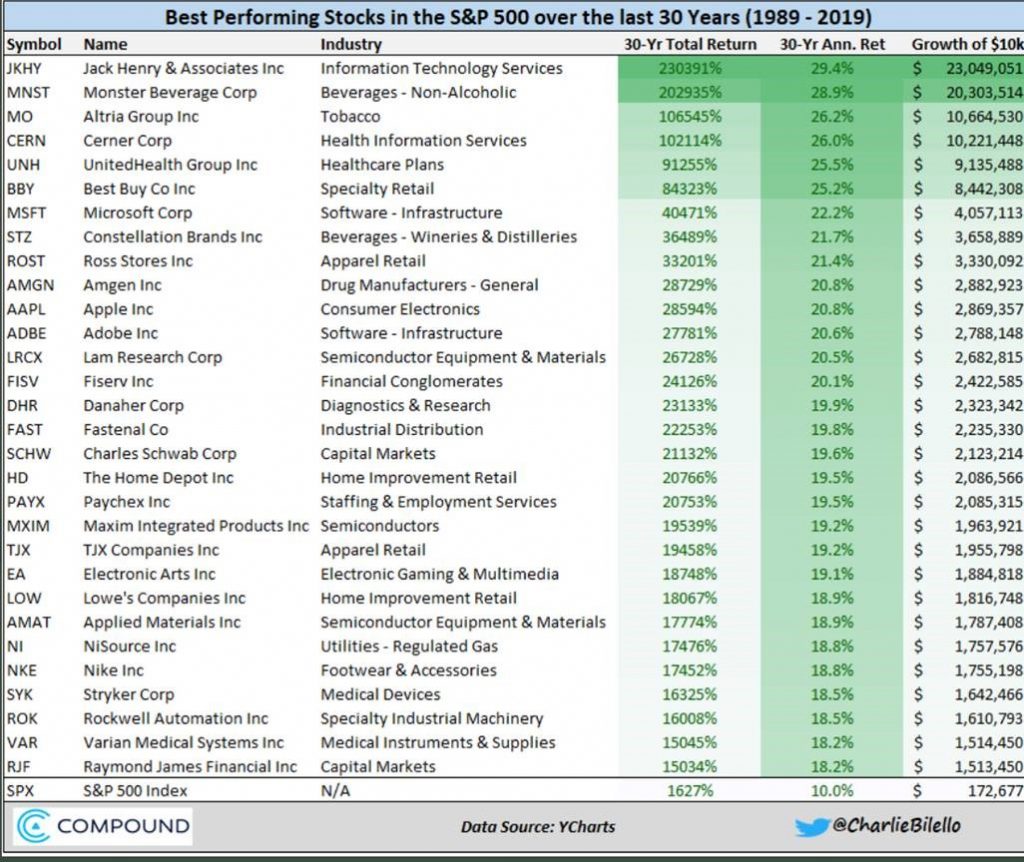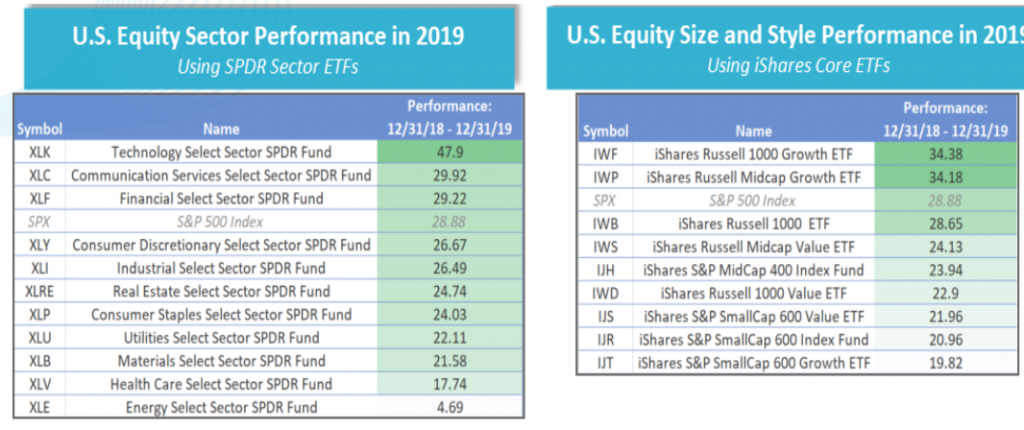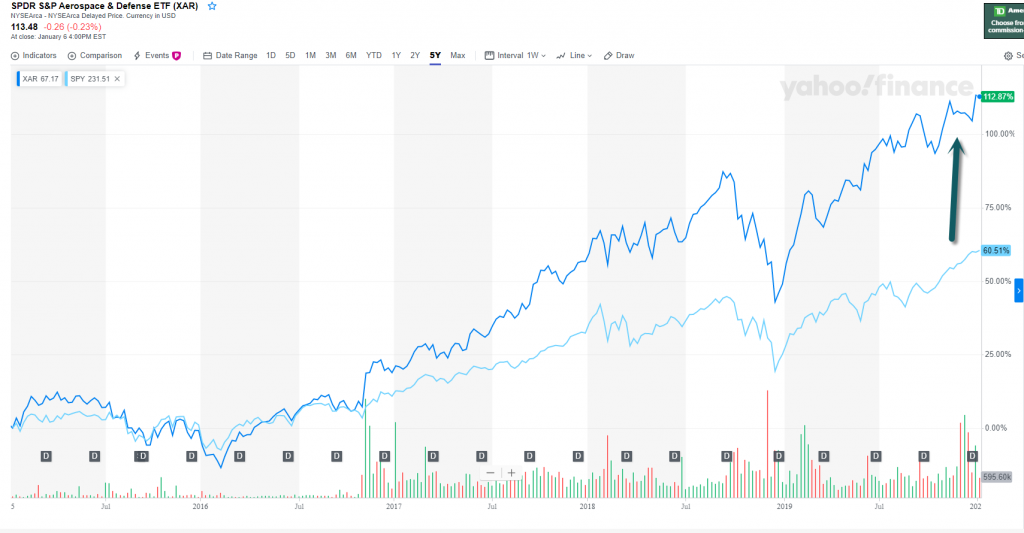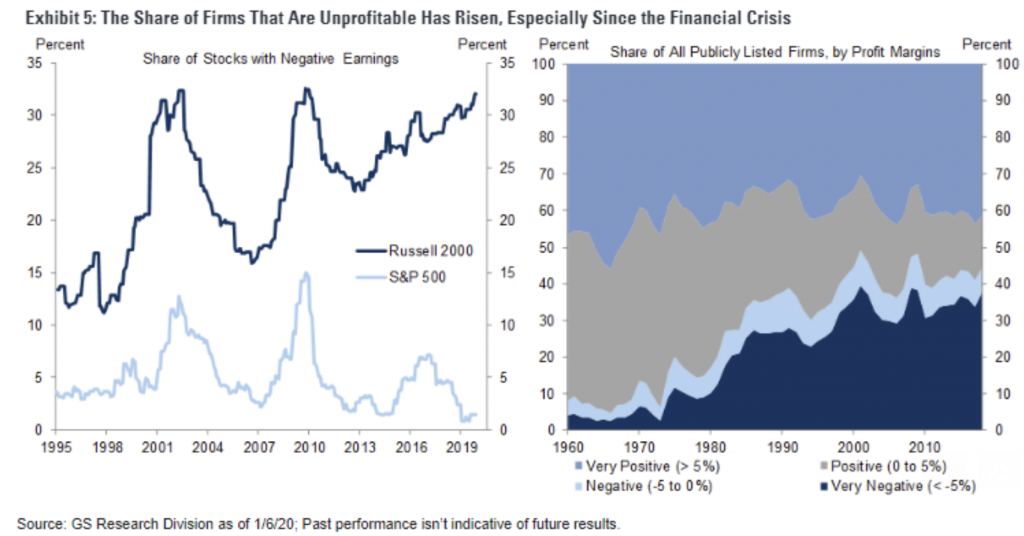1.Best Performing Stocks in the S&P Over the Last 30 Years.
Charlie Bilello
@charliebilello

https://twitter.com/charliebilello/status/1214316298764726272/photo/1
2.Sector and Size Final Performance 2019

Nasdaq Dorsey Wright www.dorseywright.com
3.XAR Aerospace ETF Returns Almost Double the S&P The Last 5 Years.
XAR +113% vs. S&P +60%

4.Saudi Aramco Market Value Has Sunk by $200 Billion Since Post-IPO Peak.
- Saudi Aramco’s market value has fallen by $200 billion since its mid-December peak, and the stock’s downtrend is accelerating in the wake of heightened tensions between the US and Iran.
- The world’s most highly valued company fell 1.7% Sunday and as much as 1.2% Monday. The two-day drop placed shares at their lowest level since the firm’s December 11 IPO.

Saudi Aramco has seen $200 billion of market value erased since its record-shattering IPO as Mideast tensions drag it lower-Ben Winck
5.The Share of Firms That Are Unprofitable in Russell 2000 Approaching Previous Highs.
GOLDMAN SACHS

Midwestern Hedgie
6.The U.S. Household Total Liabilities as a % of Disposable Personal Income.

The 2010s in ReviewBY BENJAMIN HARDEE, Ph.D.
Silicon Hills Wealth Management https://siliconhillswealth.com/the-2010s-in-review/
7.Lowest Household Debt Service to Income Obligations in 40 Years.
JP MORGAN


https://privatebank.jpmorgan.com/content/dam/jpm-wm-aem/documents/eotm/eotm-outlook-2020-am.pdf
8.In Theory Millennials Hitting Median Home Buying Age But …..Is that Age Shifting to Much Older?
Callum Thomas Topdown Charts

9.Troop Levels in Iraq.
GEOPOLITICAL TENSIONS– The killing of top Iranian commander Qassem Soleimani on Friday has heightened concerns of a widening Middle East conflict that could disrupt oil supplies from a region that accounts for nearly half of the world’s oil production. In response to Iran’s warnings of retaliation, Trump has threatened to hit 52 Iranian sites, including cultural targets, if Tehran attacks Americans or U.S. assets, deepening a crisis that has heightened fears of a new Middle East conflagration.

One of Iran’s main regional goals – driving U.S. forces out of neighboring Iraq – came a step closer on Sunday when the Iraqi parliament backed a recommendation by the prime minister for all foreign troops to be ordered out. Iraq’s rival Shi’ite leaders, including ones opposed to Iranian influence, have united since Friday’s attack in calling for the expulsion of U.S. troops.
From Dave Lutz at Jones Trading.
10.Start the New Year Off Right With These 7 Simple Time Management Tips
Todd Cherches
CEO and Management & Leadership Consultant and Executive Coach at BigBlueGum… See More
46 articles Following
OK, you’ve made your new year’s resolutions…but now what? Where and how do you start?
As the management guru Peter Drucker famously put it, “Time is the scarcest resource; if it is not managed, nothing else can be.” So how are you going to manage your time . . . while you try to manage to find the time to do all that you need to do this year?
There are a million time management and personal productivity tools, tips, and techniques out there. You can spend hours researching all of them (but then you really wouldn’t get anything done), or you can start with any of the following seven simple tips that I’m suggesting below — all of which I use, in one way or another, to get stuff done.
While many of these techniques may at first glance appear to be just common sense…as the saying goes, “Common sense is not always common practice.” And it is putting these ideas into practice — to achieve results — that really matters.
So here are seven of my favorite time management methods to help you get the most—and the best—out of your day, week, month, and year:
1. The To-Do List or Master Checklist – So simple and obvious, and yet most people just don’t have one. You may have a collection of scraps of paper scattered about, Post-it Notes stuck to your computer, or random scribbles in a notebook or on your phone, but most people do no have ONE single organized and detailed “Master List” of everything you need to do all in one place. If you do nothing else, do this. Consolidate. Life is complex enough, so anything you can do to simplify will help. Having everything in one place will not only help you to get your life more organized, so that you can find everything at a glance, it will reduce stress by helping you to get your brain more organized, thereby freeing you up to think more clearly, make better decisions, innovate, and succeed. As Atul Gawande’s bestselling book The Checklist Manifesto powerfully illustrates, a simple checklist can, literally, save lives. So why not start with your own?
2. Time Management Matrix (aka the Eisenhower Matrix) – Popularized by Stephen Covey in his classic book, The 7 Habits of Highly Effective People, (and discussed in even greater detail in his First Things First), this simple 4-quadrant model can help you more effectively manage your time (and your to-do list) by thinking in terms of “urgency” and “importance.” The basic premise is that if we spend all our time scrambling around, dealing with the urgent (e.g., crises, interruptions, and distractions), then when and how do we ever find the time to do the big, important things that really matter?
3. Time-Cost-Quality Triangle – Every decision we make involves these three factors. It’s up to you to determine what matters, as there are always trade-offs involved and decisions to be made — and a change in any one factor will impact the other two. (In project management terminology, we may talk in terms of Scope, Schedule, and Budget.) Do you want it done right . . . or do you want it done right now? Usually you can’t have it both ways. For example, delivering high quality tends to take more time, and often costs more. Everyone wants everything “better, faster, and cheaper,” but is that realistically possible? Even when deciding whether to walk, take the subway, or take a cab or Uber/Lyft, we’re playing these three variables off each other! This simple, triangular model won’t make the decision for you, but it will help you to prioritize and to make better and more confident decisions.
4. SMART Goals – A big part of New Year’s resolutions is setting our goals or objectives for the year. So why do we so often fail to achieve them? Because the goals we set were, most likely, not “SMART”! A “SMART” goal is:
Specific (as opposed to broad, vague, or general); Measurable (that is, quantifiable—as Drucker said, “If you can’t measure it, you can’t manage it”); Achievable (that is, a challenge and a stretch, but realistically doable); Relevant (the goal must be meaningful and significant); Time-oriented (there needs to be a deadline to be met, because what you can do “anytime” will, most likely, be done at no time).
Saying “I’d like to lose some weight this year” is a good intention; but it’s not a SMART Goal that will increase your odds of getting you there. Saying (or, better yet, writing it down and saying out loud to others who will hold you accountable): “I am committed to only eating X number of calories per day, and working out five days a week, with the realistic and tangible goal of losing 5 pounds a month over the next 6 months” is more likely to get you closer to achieving your ultimate objective than just hoping it will somehow magically happen by itself. Take it from me: Two years ago I lost a little over 10 pounds a month for 3 straight months (yes, 36 pounds total!)…and (other than a few five-pound-fluctuations) I’ve managed to pretty much keep it off ever since. I could not have accomplished this difficult feat without setting — and keeping — my SMART goals.
5. The Three B’s: Bookending, Blocking, and Batching – Very simply, these three B’s are easy to remember and not that difficult to do…if you make the time and take the time to actually do them.
Bookending: Reserve the first and last half-hour or hour of your day (e.g., 8:00am-9:00am and 5:00pm-6:00pm, depending on your schedule) for solo, silent, undistracted reflection, planning, and reading time. You could also “bookend” your week, month, and year. Not taking the time – with yourself and for yourself — to reflect, assess, strategize, and plan is a good way to spend day after day just spinning your wheels and burning out, while never getting any of the most important things done.
Blocking: If you don’t control your calendar, everyone else will. Block out a few hours a week of “me time” (even if it’s just a half hour or an hour at lunchtime), so you can recharge and refresh, and/or to actually get some real work done…rather than just running from one meeting or task to the next.
Batching: Instead of stopping and starting as things pop up, group similar things together (e.g., responding to non-urgent emails and phone calls, doing paperwork, filing, bill paying, etc.) and knock them out all at one time when you can give these low-priority (but highly important) tasks your undivided attention.
6. The 18 Minutes Method – Author Peter Bregman, in his thought-provoking and highly engaging book of the same name, recommends something similar to bookending, with an added twist: He says that you should dedicate five minutes at the start of each day for planning and five minutes at the end of the day for reflection (that’s ten of the eighteen minutes). But he also suggests you spend one minute of every hour in between (set the alarm on your watch or phone to go off each hour) to STOP…pause…and ask yourself: Is what I’m doing right now what I SHOULD be spending my time on right now?
In this day and age, it’s way too easy to go online to check Facebook “for a minute,” only to look up and realize that it’s lunchtime already and you’ve gotten absolutely nothing done. So you come back from lunch, log back in, and then go off on a “Google Field Trip” – you know…when you go online to look something up, only to find that it’s now five hours later and you can’t even remember what “that” was.
7. The Two-Minute Rule – If something will take less than two minutes (or even less than five minutes) to do, just get it done RIGHT NOW. Rather than adding it to your To-Do list, or taking ten times as long to delegate and explain it to someone else, just knock it off now and move on to the next thing. You’ll feel good about making progress as you check things off your list; and, again, it will allow you to focus on the big things. (This and other great tips can be found in David Allen’s Getting Things Done, which is probably the most popular personal productivity book out there today.)
As mentioned previously, there are tons of other related tools, tips, and techniques around, but I’ll stop here.
You’re probably thinking: I barely have time to keep up with my email and all my meetings — how am I supposed to find the time to do everything on this list? The answer is, don’t try to do everything. Just pick one or two of these suggestions—the ones you think will have the biggest immediate impact—and focus on making a few small adjustments and improvements . . . one day at a time.
Doing so is an investment. And like any long-term investment, you may not see the payoff right away, but you will see the return on investment — yes — over time. You know, the whole “journey of a thousand miles begins with a single step” and all that.
The key is to just get started.
And now is as good a time as any.
CEO and Management & Leadership Consultant and Executive Coach at BigBlueGumball; TEDx speaker; author of the book, “VisuaLeadership.” Published • 3hhttps://www.linkedin.com/pulse/start-new-year-off-right-7-simple-time-management-tips-todd-cherches-1f/?trackingId=nmeDexYjk69ONvnWua5YTA%3D%3D